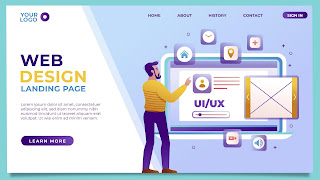Web design service
Web design service refers to the process of creating, designing, and building websites that are visually appealing, user-friendly, and effective in achieving their intended purposes. A web design service may include various aspects such as:
1. Website design: This involves designing the layout, color scheme, typography, and other visual elements of a website to create an attractive and engaging user interface.
2. User experience (UX) design: This involves creating a user-centered design that enhances the overall experience of the website's visitors. It involves designing the navigation, flow, and usability of the website to ensure that users can easily find what they're looking for.
3. Front-end development: This involves the coding and programming of the website's user interface using HTML, CSS, and JavaScript to create an interactive and responsive website.
4. Back-end development: This involves the coding and programming of the website's server-side functionalities using programming languages like PHP, Python, Ruby, or Java to create dynamic and database-driven websites.
5. Search engine optimization (SEO): This involves optimizing the website's content, structure, and code to improve its visibility and ranking on search engines like Google, Bing, or Yahoo.
6. Content creation: This involves creating and curating high-quality, informative, and engaging content for the website's visitors, such as blog posts, articles, videos, infographics, or product descriptions.
Overall, a web design service aims to create a website that meets the needs and goals of its target audience, while also aligning with the brand's vision, mission, and values.
UX and UI design methodology
UX (User Experience) and UI (User Interface) design are two essential components of web and app design. UX design is the process of enhancing user satisfaction by improving the usability, accessibility, and desirability of a product or service, while UI design focuses on creating visually appealing and engaging interfaces that facilitate user interactions.
There are several methodologies that UX and UI designers can use to create effective designs:
1. User-centered design: This approach focuses on understanding the needs and preferences of the end-users through research and testing. It involves gathering data through methods like user surveys, interviews, and usability testing, and using this data to inform the design process.
2. Design thinking: This is a human-centered approach to design that involves empathizing with users, defining their needs, ideating possible solutions, prototyping, and testing those solutions. Design thinking emphasizes creativity and innovation in problem-solving.
3. Agile design: This approach involves iterative and collaborative design processes that involve continuous feedback and improvement. It allows for rapid prototyping, testing, and refinement of designs based on user feedback.
4. Lean UX: This methodology emphasizes a streamlined approach to UX design that involves creating designs quickly and testing them early and often. It involves using data and user feedback to continuously refine and improve the design.
5. User interface design principles: UI design principles are rules and guidelines that designers can follow to create effective interfaces. These principles include simplicity, clarity, consistency, usability, accessibility, and visual hierarchy.
Overall, the methodology used by UX and UI designers may vary depending on the project's requirements, timelines, and resources. However, a user-centered approach that emphasizes testing and feedback is generally considered best practice in creating effective and engaging designs.





No comments:
Post a Comment